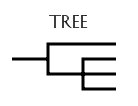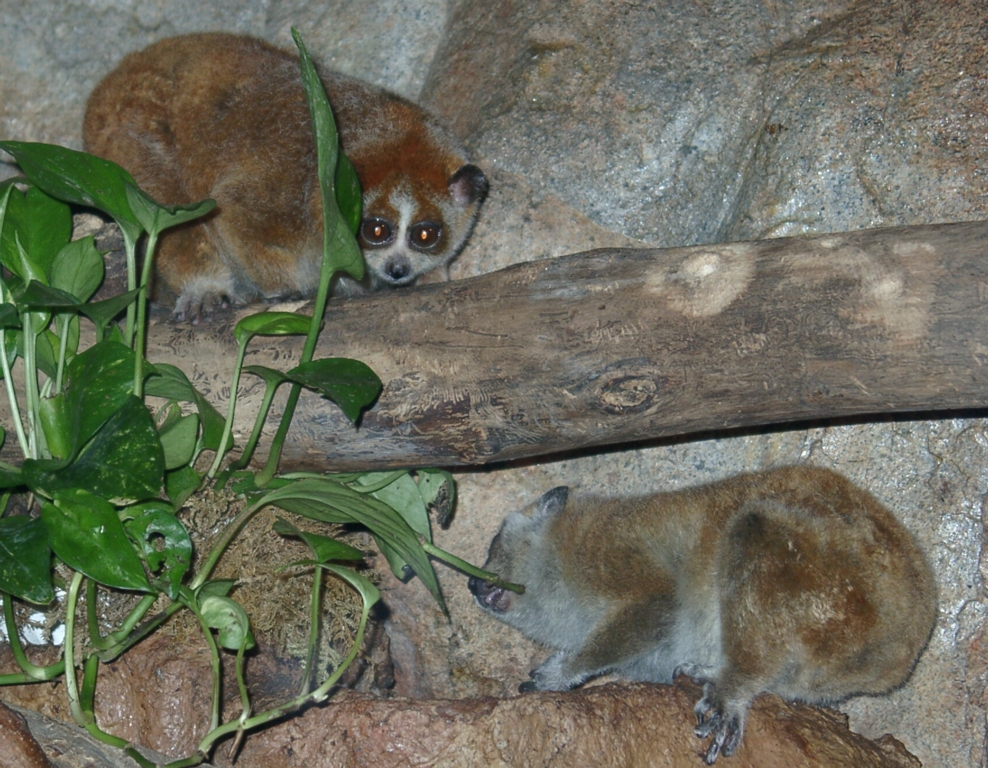| | These Pygmy Slow Lorises (Nycticebus pygmaeus) are in the suborder Strepsirrhini, the prosimians.
Chapter Outline- Description of Mammalia
- Classification of Mammalia
- Prototheria
- Metatheria
- Eutheria
- Afrotheria
- Laurasiatheria
- Artiodactyla
- Carnivora
- Euarchontoglires
- Primates
- Hominidae

NCBI Tree | Paleo Tree
Links to external sites will appear in pop-up windows. | | |
Primates are one of the orders in the superorder Euarchontoglires, discussed on the previous page. It includes monkeys, apes and humans. Humans and apes are in the family Hominidae, which will be discussed on the following page. The other families will be discussed on this page.
The only primates native to the United States are humans (Homo sapiens). Any primates to be experienced in the US will be in zoos.
- Xenarthra [38-V]
- Afrotheria [38-VI]
- Boreoeutheria
- Laurasiatheria
- Perissodactyla - Horses, Tapirs, Rhinoceroses [38-VII]
- Insectivora - Hedgehogs, Shrews, Moles [38-VII]
- Pholidota - Pangolins [38-VII]
- Chiroptera - Bats [38-VII]
- Artiodactyla [38-VIII]
- Carnivora [38-IX]
- Euarchontoglires
- Glires
- Rodentia - Rodents [38-X]
- Lagomorpha - Rabbits, Pikas [38-X]
- Dermoptera - Flying Lemurs [38-X]
- Scandentia - Tree Shrews [38-X]
- Primates
- Strepsirrhini - Prosimians
- Haplorrhini
- Tarsiiformes - Tarsiers
- Simiiformes
- Platyrrhini - New World Monkeys
- Catarrhini
- Cercopithecoidea - Old World Monkeys
- Hominoidea
- Hylobatidae - Gibbons
- Hominidae [38-XII] - Apes, Humans
The suborder Strepsirrhini includes the prosimians. As of 2024, 124 species of Strepsirrhini have been observed in iNaturalist throughout the world.
- INFRAORDER CHIROMYIFORMES
- FAMILY DAUBENTONIIDAE
- Aye-Aye (Daubentonia madagascariensis) - 6 (Omaha Zoo) - YOUTUBE
- INFRAORDER LEMURIFORMES
- FAMILY CHEIROGALEIDAE - DWARF AND MOUSE LEMURS
- Fat-Tailed Lemur (Cheirogaleus medius) - 6 (Omaha Zoo)
- Hairy-Eared Dwarf Lemur (Allocebus trichotis)
- Mouse Lemurs (Microcebus spp.)
- Mouse Lemurs (Mirza spp.)
- Fork-Marked Lemur (Phaner furcifer)
- FAMILY INDRIIDAE
- (Archaeolemur spp.)
- Woolly Lemurs (Avahi spp.)
- (Hadropithecus stenognathus)
- Indri (Indri indri)
- Coquerel's Sifaka (Propithecus coquereli) - 6 (St. Louis Zoo)
- FAMILY LEMURIDAE - LEMURS
- White-Headed Brown Lemur (Eulemur albifrons) - 6 (Omaha Zoo)
- Collared Brown Lemur (Eulemur collaris) - 6 (Omaha Zoo)
- Common Brown Lemur (Eulemur fulvus) - 6 (Omaha Zoo)
- Black Lemur (Eulemur macao macao) - 6 (Omaha Zoo)
- MongooseLemur (Eulemur mongoz) - 6 (Omaha Zoo)
- Bamboo Lemurs (Hapalemur spp.)
- Ring-Tailed Lemur (Lemur catta) - 6 (Omaha, St. Louis and Denver Zoos) - NOAH
- Red-Ruffed Lemur (Varecia rubra) - 6 (Omaha and Denver Zoos)
- Black and White Ruffed Lemur (Varecia variegata) - 6 (St. Louis Zoo)
- FAMILY LEPILEMURIDAE - SPORTIVE LEMURS
- Sportive Lemurs (Lepilemur spp.)
- (Megaladapis edwardsi)
- INFRAORDER LORISIFORMES
- FAMILY GALAGIDAE - GALAGOS
- Western Needle-Clawed Galago (Euoticus elegantulus)
- Galagos & Bushbabies (Galago spp.)
- Galagos (Galagoides spp.)
- Greater Bushbaby (Otolemur crassicaudatus) - 6 (KC Zoo) - NOAH
- Small-Eared Galago (Otolemur garnettii) - 6 (Omaha Zoo)
- FAMILY LORISIDAE - LORISES
- Angwantibos (Arctocebus spp.)
- Slender Lorises (Loris)
- Pygmy Slow Loris (Nycticebus pygmaeus) - 6 (Omaha Zoo, Lied Jungle) - NOAH
- Potto (Perodicticus potto) - 6 (Omaha Zoo)
The infraorder Tarsiiformes contains the Tarsiers. As of 2024, 11 species of Tarsiiformes have been observed in iNaturalist throughout the world.
The parvorder Platyrrhini contains the New World Monkeys of Central and South America. As of 2024, 167 species of Platyrrhini have been observed in iNaturalist throughout the world.
- FAMILY AOTIDAE
- Douroucouli (Aotus trivirgatus) - 6 (Omaha Zoo)
- FAMILY ATELIDAE
- SUBFAMILY ALOUATTINAE
- Howler Monkey (Alouatta sp.) - 6 (Omaha Zoo)
- SUBFAMILY ATELINAE
- Colombian Brown Spider Monkey (Ateles belzebuth hybridus)
- Brown-Headed Spider Monkey (Ateles fusciceps robustus) - 6 (Omaha Zoo)
- Black-Handed Spider Monkey (Ateles geoffroyi) - 6 (Omaha and St. Louis Zoos) - NOAH
- Woolly Spider Monkey (Brachyteles arachnoides)
- Woolly Monkeys (Lagothrix spp.)
- FAMILY CEBIDAE
- SUBFAMILY CALLITRICHINAE
- Goeldi's Marmoset (Callimico goeldii)
- Geoffrey's Marmoset (Callithrix geoffroyi) - 6 (Denver Zoo)
- Black-Tufted-Eared Marmoset (Callithrix kuhlii) - 6 (Omaha Zoo)
- Pygmy Marmoset (Callithrix pygmaea) - Omaha Zoo, Lied Jungle - NOAH
- Weid's Black-Tufted-Ear Marmoset (Callithrix kuhlii) - NOAH
- Golden Lion Tamarin (Leontopithecus rosalia) - 6 (Denver Zoo)
- Emperor Tamarin (Saguinus imperator) - 6 (Denver Zoo)
- Cotton-Top Tamarin (Saguinus oedipus) - 6 (KC and St. Louis Zoos)
- SUBFAMILY CEBINAE
- White-Fronted Capuchin (Cebus albifrons) - 6 (Omaha Zoo)
- Brown Capuchin (Sapajus apella) - 6 (Denver Zoo)
- SUBFAMILY SAIMIRIINAE
- Squirrel Monkey (Saimiri sciureus) - 6 (SCZ and Omaha Zoos)
- FAMILY PITHECIIDAE
- SUBFAMILY CALLICEBINAE
- Bolivian Gray Titi Monkey (Plecturocebus donacophilus) - 6 (Denver Zoo)
- SUBFAMILY PITHECIINAE
- Uacaris (Cacajao spp.)
- Red-Backed Bearded Saki Monkey (Chiropotes sp.) - 6 (Omaha Zoo)
- White-Faced Saki Monkey (Pithecia pithecia) - 6 (KC, Denver and St. Louis Zoos)
The superfamily Cercopithecoidea contains a single family of Old-World Monkeys, from Africa and Asia: Cercopithecidae. As of 2024, 146 species of Cercopithecoidea have been observed in iNaturalist throughout the world.
- FAMILY CERCOPITHECIDAE - OLD WORLD MONKEYS
- SUBFAMILY CERCOPITHECINAE
- Allen's Swamp Monkey (Allenopithecus nigroviridis) - 6 (KC and St. Louis Zoos)
- Black Mangabey (Cerocebus aterrimus) - 6 (KC Zoo) - NOAH
- Red-Capped Mangabey (Cerocebus torquatus) - 6 (KC Zoo) - NOAH
- Diana Monkey (Cercopithecus diana) - 6 (KC Zoo)
- Blue Monkey (Cercopithecus mitis) - 6 (KC Zoo)
- Mona Monkey (Cercopithecus mona) - 6 (KC Zoo)
- De Brazza's Monkey (Cercopithecus neglectus) - 6 (Omaha Zoo, Lied Jungle), 9 (ABQ Biopark) - NOAH
- Wolf's Guenon (Cercopithecus wolfi) - 6 (Omaha Zoo)
- Green Monkeys (Chlorocebus spp.)
- Red Guenon (Erythrocebus patas)
- Mangabeys (Lophocebus spp.)
- Lion-Tailed Macaque (Macaca silenus) - Sun Bear Forest
- Mandrill (Mandrillus sphinx) - 6 (Denver Zoo)
- Talapoins (Miopithecus spp.)
- Guinea Baboon (Papio hamadryas papio) - 6 (KC Zoo)
- Highland Mangabey (Rungwecebus kipunji)
- Gelada Baboon (Theropithecus gelada)
- SUBFAMILY COLOBINAE
- Guereza Colobus Monkey (Colobus guereza) - 6 (SCZ and St. Louis Zoos)
- Proboscis Monkey (Nasalis larvatus) - YOUTUBE
- Red Colobuses (Piliocolobus spp.)
- Olive Colobus (Procolobus verus)
- Douc Langurs (Pygathrix spp.)
- Snub-Nosed Monkeys (Rhinopithecus spp.)
- Sacred Langurs (Semnopithecus spp.)
- Francois' Langur (Trachypithecus francoisi) - 6 (Omaha Zoo, Lied Jungle) - NOAH
- Spectacled Langur (Trachypithecus obscurus) - 6 (St. Louis Zoo)
The superfamily Hominoidea contains two families of Apes. Apes are distinguished from monkeys by their lack of tails. Hylobatidae, the family of Gibbons, is covered in this section and the family of Great Apes, Hominidae, will be explored on the next page.
As of 2024, 18 species of Hylobatidae have been observed in iNaturalist throughout the world, located in Southeast Asia.
- FAMILY HYLOBATIDAE - GIBBONS
- Hoolock Gibbons (Hoolock spp.)
- White-Handed Gibbon (Hylobates lar) - 6 (Omaha Zoo, Lied Jungle) - NOAH
- White-Cheeked Gibbon (Hylobates leucogenys) - 6 (KC Zoo)
- Gray Gibbon (Hylobates muelleri) - 6 (Omaha Zoo)
- White-Cheeked Gibbon (Nomascus leucogenys) - 6 (Denver Zoo)
- Siamang (Symphalangus syndactylus) - 9 (ABQ Biopark), Tulsa Zoo
- FAMILY HOMINIDAE - GREAT APES
| |

